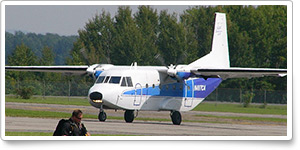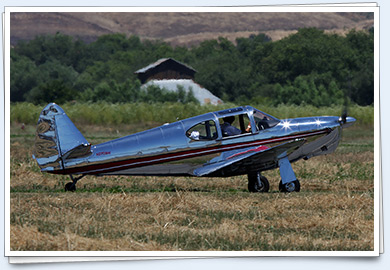Mar. 29, 2013, issue of 'AOPA ePilot: Flight Training Edition' weekly newsletter
| ||||||
| Agonic airports |
| |||||
Training TipsAgonic airports
Hold on—didn’t we skip a step? What about adjusting for magnetic variation, calculating a magnetic heading, and applying the mnemonic “ East is least and west is best”?
Good catch—but this is a special case. Check the chart, and see that both the departure and destination airports are located almost astride the agonic line, where magnetic variation is zero. That is, on the agonic line, true north and magnetic north coincide.
That may sound like a strange idea to a pilot who learned to fly and navigate in Elma, Wash., where magnetic variation is 17 degrees east, or in Caribou, Maine, where variation is 17 degrees west.
Why is variation expressed as easterly on the West Coast, and as westerly on the East Coast?
“On the west coast of the United States, the compass needle points to the east of true north; on the east coast, the compass needle points to the west of true north,” explains Chapter 15 of the Pilot’s Handbook of Aeronautical Knowledge, which also provides an isogonic chart as an illustration. (Remember that the lines on your sectional chart that show the degrees of variation to apply in a given area are known as isogonic lines, or lines of equal variation.)
And between the zones where easterly and westerly variation applies sits the agonic line. A dictionary definition of agonic is “not forming an angle.”
In the United States the agonic line runs approximately west of the Great Lakes, south through Wisconsin, Illinois, western Tennessee, and along the border of Mississippi and Alabama.
You have probably checked your own airport's variation often enough to have the value memorized. But if you compare it to the variation given on older editions of the same navigation chart, you may be surprised to see that it has changed with time.
That explains why older discussions of the agonic line in articles and texts place it in a different position; not too long ago it ran through the southeastern tip of Florida—where variation is now 6 degrees west! Flight Training NewsTower’s closed, what now?If you are one of the pilots in 37 states affected by the closure of 149 control towers, do you remember nontowered procedures? As one AOPA staffer said, “Now we go back to the way we did it 50 years ago.” As you might expect, AOPA has lots of information on proper nontowered procedures. We prefer “nontowered” to “uncontrolled” because the great, unwashed nonpilots of America confuse “uncontrolled” with out of control. That’s not the case. If recommended procedures are followed, there is nothing “uncontrolled” about arrivals and departures at an airport without a tower. Read more >> AEA awards more than $125,000 in scholarshipsThe Aircraft Electronics Association Educational Foundation on March 26 awarded more than $125,000 in individual scholarships to 26 students preparing for a career in the general aviation and aircraft electronics industry. The scholarships were announced during the AEA International Convention and Trade Show in Las Vegas, the continuation of a program that has awarded more than $1.5 million since the foundation was created in 1990 to “enhance, promote and secure the future of aviation maintenance.” Awards range from $1,000 to more than $40,000 each. Applications for 2014-2015 scholarships will be available after Oct. 1. From touchdown to tiedown: Aircraft tiresThey sit immobile, baking in the hot sun or hardening in the freezing cold for weeks at a time until they’re called upon to go from 0 mph to 60 mph faster than any earth-bound speedster. And, although they are among the most stressed components of the average general aviation aircraft, they are often the most undervalued. Inspecting tires should be a key part of your preflight inspection. Read more >> Need a checklist? Check out these appsGoing through a checklist before taking to the skies and during flight is a must. In the past, pilots relied on paper/laminated checklists, but with the advent of smartphones and tablets, checklists have become digital. This week, AOPA highlights five checklist apps recommended by members. Read more >> US-based summer aviation camp targets Chinese teensA Taiwan-born entrepreneur is targeting Chinese students aged 15 to 18 for a summer camp that offers glider flight training and teaches leadership skills, coupled with preparing them for a college education in the United States. Aviation Camp Enterprises, founded by pilot Hong Yu, will offer a three-week study and tour abroad summer program. Read more >> Lainey's first flightWhen Bobby Woodson took his 6-year-old daughter Lainey for her first airplane ride last fall, he had no idea that their sunset trip around a grass strip in South Carolina would become an Internet sensation. But more than 150,000 people have watched the YouTube video—and that number is growing rapidly. “It’s taken me completely by surprise,” said Woodson, 40, a corporate jet pilot based in Charlotte, N.C. Read more >> AOPA awards two student pilot scholarships at WAI conferenceAOPA and the AOPA Foundation awarded two scholarships each worth $3,000 to student pilots March 16 during the annual International Women in Aviation conference in Nashville, Tenn. Read more >> Learn photography, video techniques in the April Facebook chatDo you take photos in flight? Is a video camera a fixture in your airplane? You’ll want to join Flight Training editors Ian J. Twombly and Jill W. Tallman for the next live Facebook chat. The guest chatter will be AOPA Staff Photographer Chris Rose, who will share some of the techniques he uses to bring you the great photography and videos from AOPA’s magazines and website. Join them at 3 p.m. Eastern time on Tuesday, April 2. Visit the website and click the chat icon to set an email reminder and view transcripts of previous chats. Cirrus endorses touchscreen flight simulatorThe training department at Cirrus recently put its stamp of approval on the FlyThisSim’s Touch Trainer, a touchscreen flight simulator. Read more >> Now you’re talkingFor many pilots, one of the hardest obstacles to overcome while learning to fly is effectively communicating with others—whether that be with air traffic controllers or other pilots on the ground or in the sky. Aspire to be the smartest pilot in the airspace by brushing up on the latest terminology and phraseology. Take the Air Safety Institute’s Say It Right: Mastering Radio Communication online course. Take the course >> Training ResourcesThe Air Safety Institute offers free Runway Safety Flash Cards, created to help pilots better understand runway signage and markings. The front of each card displays an airport sign or pavement marking, while the back provides a description and information on the required pilot action. Download the cards >>
Did you know that student pilots who join AOPA are three times more likely to complete their flight training? Membership includes unlimited access to aviation information by phone (800/USA-AOPA, weekdays from 8:30 a.m. to 8 p.m. Eastern time) or from Flight Training Online or AOPA Online. If you’re not already a member, join today and get the pilot’s edge. Login information is available online. ABC News throws GA under bus; Harrison Ford on Capitol HillAOPA is setting the record straight after ABC News unfairly attacked general aviation safety in a report chock-full of misinformation. Harrison Ford speaks up for GA on Capitol Hill. And take stock in your well-being and perhaps extend your flying career as AOPA introduces Fly Well, a new series on your health and piloting. Catch up on AOPA Live This Week, March 21. Career PilotAmerican reports record load factorAMR Corp. on March 8 reported February 2013 consolidated revenue and traffic results for subsidiaries American Airlines Inc. and AMR Eagle Holding Corp. Consolidated load factor in February was an all-time record high for the month at 77.9 percent, 2.6 points higher than the same period last year. Consolidated capacity and traffic were 4.4 percent and 1.1 percent lower year-over-year, respectively.
For more aviation career news, see the Flight Training website. Plane SpotterCall it unretractable: CASA 212 Training ProductsSporty’s announces instrument training appSporty’s Complete Instrument Training course, available in online and DVD formats, is now a dedicated app for iOS devices. Formatted specifically for the iPhone or iPad, the app includes 13 hours of real-world video and advanced graphics including 3-D animations to help explain difficult concepts, Sporty’s said. Read more >> Gleim offers LSA pilot training kitGleim Aviation has made available its Deluxe Sport Pilot Kit, an all-in-one program designed to expedite training for this certificate. The kit includes online ground school, FAA test prep, a flight bag, flight computer, FAR/AIM, a logbook, and training materials. The cost is $199.95.
Note: Products listed have not been evaluated by ePilot editors unless otherwise noted. AOPA assumes no responsibility for products or services listed or for claims or actions by manufacturers or vendors. Member BenefitsTitle issues don’t go awayIt is not very convenient to research the status of an aircraft title, but it’s a step we should not skip. One aircraft owner purchased his first aircraft when it was less than a year old, had been used as a demonstrator for 50 hours, and was owned by an aircraft dealership. Since he paid cash, no bank required a title search, and he did not request one. Nearly 14 years later, he decided to sell it—and got an unpleasant surprise. Read more >> Emergency Assistance Plus offers tips for healthy travelWhen it comes to planning a trip most will do their due diligence when creating a budget, selecting a hotel, and deciding which mode of transportation to use. However, one often overlooked aspect is also one of the most important—your health. Emergency Assistance Plus has a few easy tips for healthy travel. Read more >> BlogsUpdate: Brush up on safety skills, help the Air Safety InstituteOn Feb. 7, AOPA eNewsletter and Social Media editor Benét J. Wilson wrote a blog post and story on AOPA member Shannon Osborne, a member of the North Jersey chapter of The Ninety-Nines, who had come up with an unusual idea to help keep pilot skills sharp when bad weather limits winter flying. She pledged to donate $5 to the AOPA Foundation’s Air Safety Institute for every course the 16 members of The Ninety-Nines chapter took in the month of February. Read more >> AOPA Career OpportunitiesEver dream of turning your passion for aviation into a career? We’re looking for an advertising marketing manager; mid-level gift specialist; network support engineer; marketing manager, fundraising and acquisitions; aviation technical specialist; staff assistant/PAC coordinator; president, AOPA Insurance Services; director, financial planning and analysis; office services supervisor; major gifts officer; and director of outreach and events. To learn more about other AOPA career opportunities, visit AOPA Online. Community
AVIATION EVENTS & WEATHER
| ||||||||||||||||||||||||||||||||||||









